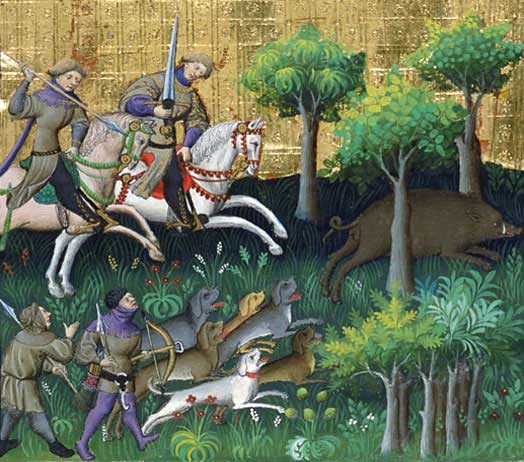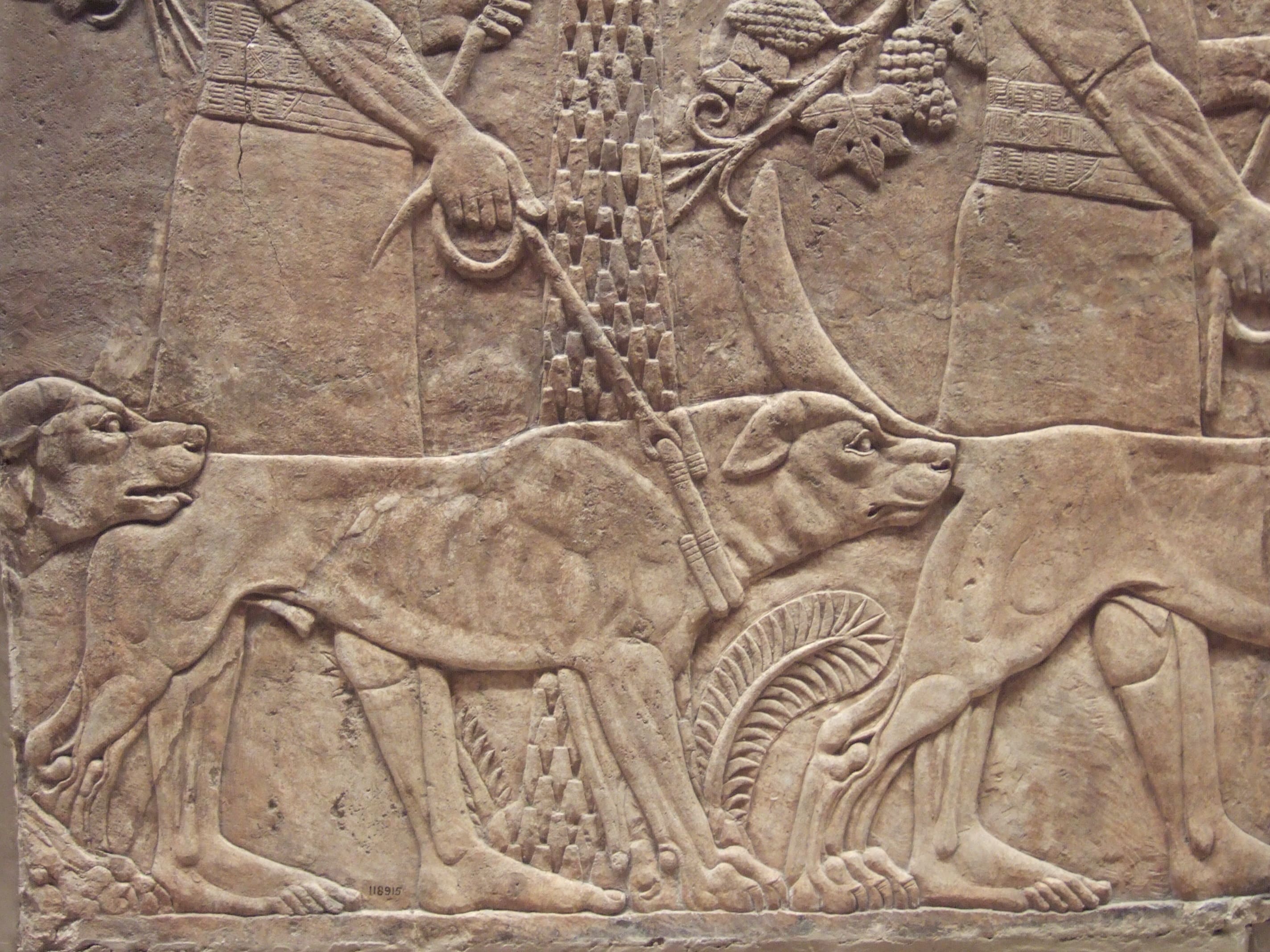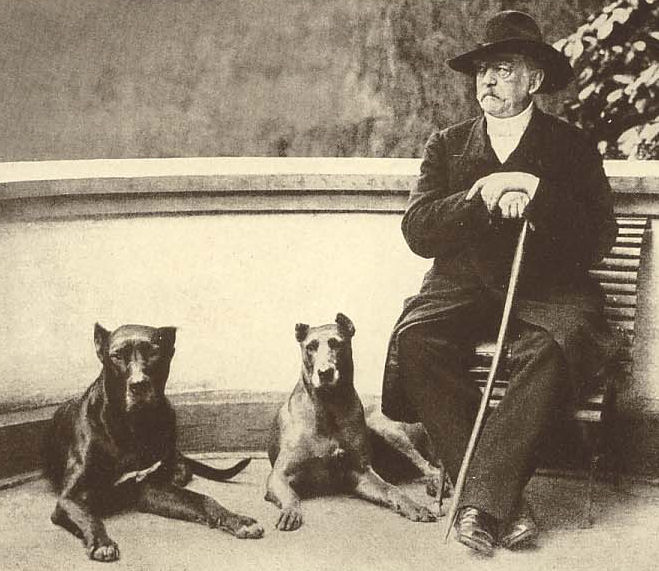The great dane breed history
“The Great Dane in his noble appearance combines a large, powerful well constructed body with pride, strength and elegance. By substance together with nobility, harmonious appearance, well proportioned outlines, as well as an especially expressive head, the Great Dane strikes the onlooker as a noble statue, never coarse or with refined elegance. Perfect in balance and always with clearly defined sexual dimorphism. He is the Apollo amongst all breeds.” This is how the FCI presents the Great Dane.
A little bit about the breed history:
Imagine a huge beast, very bad tempered, with sharp defenses and weighing at least 100kg: I present you the European boar. These animals used to brake in the forests, endangering the population and decimating agriculture. In the Middle Ages, aristocrats considered hunting these animals a sport.
Accompanying the hunters on horseback, there were packs of giant dogs of great agility, courage, strength and perseverance. These dogs have often been traded between princely estates in England, Germany, Denmark and elsewhere, and it is recognized that these medieval hunting dogs are the ancestors of today’s great dane.

In the 16th century, the royal courts of Denmark introduced the new method of hunting “By force” - an artificial hunting where the dogs had to hunt the prey and maintain it until the hunter arrives to touch it. That dogs were not equipped to play this role: They were too light to hold the prey. To solve this problem, King Frederick II of Denmark (regent 1559-1588) imported English puppies, donated by Queen Elizabeth I, which were the most powerful of the English mastiffs and which, when mixed with his dogs, is become the foundation of the current Great Dane.
The largest and best of these dogs wore beautiful collars and were known as Kammerhunde (chamber dogs) because they lived in the rooms with the nobles. In Antiquity, we find dogs of similar appearance in works of art. The oldest are engravings of Egyptian tombs, dating from around five thousand years ago, of dogs remarkably similar to the great mastiff.

According to paintings and tapestries of that time, these dogs of the Middle Ages were not all of the same type. All were giants, and their colors covered the whole range of what appears in the modern Great Danes. Nobody knows which breeds were mixed to produce them, but it is supposed that the Irish greyhound, the “Mastins”, the “Alaunts” (unspecified race spread in Europe by the nomadic Eastern population of Alani. The race disappeared in the XVIIth century after dispensing its genetic inheritance within different races), the Tibetan Mastiff and the old Assyrian “battle dogs” have contributed. The harlequin pattern is probably a gift from the Egyptian greyhound, long gone.

The great dane’s predecessors were also used to hunting and went to war in Roman times. Dogs resembling to mastiffs have been used through the ages for milder activities, such as pulling carts, as guard dogs and as harness dogs to precede the entourage of the nobles.
The development of the modern Great Dane began around the middle of the 19th century, with the advent of competitive dog shows. A preliminary breed standard was developed in Germany in 1800 and its popularity could be influenced in this country by the fact that the chancellor, prince Otto von Bismarck was a great amateur and had several danes. Later in the century, the Great Dane was adopted as the German “national dog” and its various names were discarded in favor of Deutsche Doggen (German Dog). Strangely, in France, the name of Great Dane is used and the French name Great Danois is only used in Scandinavia and Quebec. Italy calls it Alano (a heritage of the Alaunt?).
The German Deutsche Doggen-Club in 1888 set the standard for the breed.

General appearance:
The Great Dane is the breed of balance: its mass and its power must be in harmony with its elegance, not looking as heavy as a mastiff, nor light as a greyhound.
It is vital that the head is long and narrow, with the stop pronounced. The skull should be flat, with parallel lines. The muzzle, full and square. Unlike the Mastiff, that has a short and stocky head, not very pronounced stop and round skull. In the Great Dane, the length of the skull must be equal to that of the muzzle (from the tip of the nose to the point between the eyes). The expression is very important: we often meet dogs with correct heads but with “something” missing. Another very important point is the sexual dimorphism: the females are more delicate and feminine and the males, distinctly masculine.
Leaky or too profuse lips, soft or detached are considered defects.
The eyes should be medium, round, as dark as possible, with a lively and intelligent expression. Blue eyes in harlequins are tolerated. Too open or fallen eyes, with a sagging lower eyelid is also a defect.
The size of the truffle must be proportional to the width of the chamfer, black for all colors. A certain degree of depigmentation (pink trouble) is accepted in harlequins.
The correct toothing for the great dane is the scissor bite.
The standard of the breed in Europe requires naturally drooping ears, of medium size, set high, neither detached nor pressed against the cheeks. Cutting the ears is prohibited by Swiss law and in most European countries.
The concept “fit for function” is vital: the Great Dane is not only a beautiful statue! He needs to be able to run, jump and play. Its’ body must be as square as possible with an almost straight dorsal line, without abrupt interruptions and the tail is of medium length, without exceeding the hock.
The neck should be long, dry, muscular, not short or thick. With its well-developed attachment, it refines slightly up to the head, giving elegance to the great dane.
The shoulders and legs must be well muscled and have good angles to guarantee free movement and the chest, developed, but like everything in the breed, without exaggeration. You need long, strong legs, well-rounded feet and short fingers.
The Hair of the Dane is short, tight and shiny and the colors are fawn, brindle, black, harlequin (pure white with irregular black spots) or blue. The Merle variety (the gray background with black spots) are accepted, but not desired. Small white spots in all varieties are accepted but not desired and the nails should be black.
The breed standard defines a minimum height at the withers of 80cm for males and 72cm for females.
Behavior and Character:
The FCI standard perfectly describes the character of the great dane: very affectionate, friendly and loyal, attached to his family. He is not a kennel dog, but a perfect “salon dog”: he enjoys the company of his family and is able to spend hours beside his human, always waiting for a hug.
While the other breeds will be busy sniffing elsewhere, the Great Dane will not be difficult to find: it is always by your side. He is tall and strong, but also very sensitive.
It can be reserved towards foreigners. It is a very friendly breed, sober and distant with strangers. He usually meets new people with quiet self-confidence, not entirely suspicious, but reserved.
Aggression is rare in the great dane (always look for breeders concerned with the good character of his blood lines and not only with appearance!) And is considered a very serious fault, even excluding by the standard.
He is a confident, fearless, easy to train, sweet family dog with a high threshold for reaction and without aggressiveness.
Family life:
When you have shared your life with a Great Dane, it is almost impossible to change to another breed! These are the opinions I hear from people who have just lost their mate after years of love and bonding.
We tend to believe that these huge dogs need a lot of space to feel comfortable. But in fact, the Great Dane enjoys a lot being inside. It is well adaptable, able to remain quiet for hours with their owners, but also be ready for long walks and adventures with more dynamic families.
Like all dogs, Great Danes ask for supervision when in the presence of children, but despite its size, it is delicate and patient. The same in the presence of the elderly: we need to be aware of the danger of an unexpected movement in a dog this size.
Education:
It takes time to educate a Great Dane and that must happen smoothly. Education and socialization are essential for all dogs but compared to its giant size and its weight in adulthood which can make its control very complicated, it is a must that the Great Dane is properly trained from its youngest age. A bad education is paid dearly with a dog of this size.
Sometimes education is not obvious because it is a fairly stubborn hunting dog and remains an eternal adolescent in its head (a Great Dane is considered a real adult only around 2.5 years old). If your dream is to become a true professional in Agility or Hoppers, the Great Dane is not for you: they are totally able to work in these categories, but considering its size and weight, they are never going to have a performance of a pro as a border collie or an Australian shepherd!
Breed needs:
It is important to keep in mind that the Great Dane is an expensive dog: veterinary, medication and food costs are as great as the dog!
It is necessary to be particularly vigilant during the first year of life of the puppy, during which it’s growth is very fast: intense physical exercises (stairs, long walks, abrupt games …) are to be avoided until its growth is not completed and a healthy diet not too rich in protein, advised by the breeder (and veterinarian!) is essential to avoid bone disorders.
It is necessary to guarantee a very thick bed to avoid the appearance of calluses, mainly in the areas on which the dog is used to lean.
Health:
Again, the choice of breeder is vital: responsible breeders carry out rigorous health checks, such as hip dysplasia, heart and genetic problems, before planning a litter and avoiding future health problems.
“Three years old a young dog. Three years a good dog. Three years an old dog. The rest is a blessing from God “: it is an expression used to describe the Bernese Mountain Dogs that is also applicable to the Great Dane. At around six years of age, the Dane begins to show signs of age. The Great Dane, unfortunately, has a shorter life than that of dogs of other breeds (especially smaller ones), like all giant breeds. But the joys and satisfactions it will bring you will make you forget the inconvenience caused by aging.
Again, choosing a breeder concerned with the longevity of his lines can make a huge difference.
A word on gastric torcion:
Even if for years I have never had a case of gastric torsion among my dogs, it is impossible to talk about the health of the Great Dane and ignore the dilation-torsion of the stomach syndrome. The Bloat is an absolute veterinary emergency, potentially fatal, which must be taken care of as soon as possible!
This condition, frequently encountered in large breed dogs and / or with deep thorax (Great Dane, German Shepherds, Saint-Bernards, boxers, among others), begins with a dilation of the stomach by liquid, food or air. Thereafter, the stomach turns on itself and can then no longer drain. The dog will start with vomiting efforts. The dilation and twisting of the stomach can interfere with the blood supply to the stomach wall and a necrosis can start. Significant distension of the stomach can prevent the return of blood from the abdomen to the heart and cause shock.
The main symptoms are unsuccessful efforts to vomit, the dog turns around in nervousness and does not lie down, a significant salivation (white foam), gasping, difficult breathing, swollen belly and a deterioration of the general state of the dog which shows signs of pain.
To try to avoid gastric torsion, you must: give meals in a raised bowl to reduce air intake; split meals avoiding large volumes or taking large volumes of water; avoid stress; avoid the dog eating too quickly; avoid strenuous physical activities 2 hours before and after the meal.
If you observe these symptoms in your dog, do not hesitate: you must go to the veto right away!
In summary, the great dane is an imposing, statuesque dog, with a heart compatible with its giant size. I hope this text made you want to get to know the Apollo better and maybe share your life with these nice giants. But you have to be careful: there is a huge potential for addiction as soon as you have close contact with the breed!